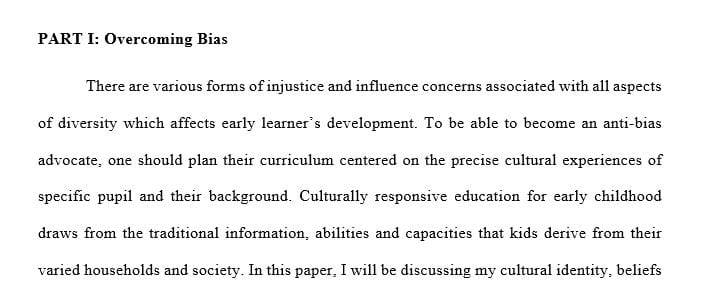Describe yourself including any relevant information about your own social identity and culture.
Your response to this Assessment should:
Reflect the criteria provided in the Rubric.
Adhere to the required assignment length.
Use the APA course paper template available here.
Before submitting your Assessment, carefully review the rubric. This is the same rubric the assessor will use to evaluate your submission and it provides detailed criteria describing how to achieve or master the Competency. Many students find that understanding the requirements of the Assessment and the rubric criteria help them direct their focus and use their time most productively.
This assessment has four parts. Click each of the items below to complete this assessment.
In order to be an effective early childhood educator and anti-bias advocate, it is necessary, first and foremost, to recognize and challenge one’s own biases. While this may not seem difficult on a surface level, there are, in fact, various strategies and practices for recognizing the overt and more subtle or covert biases one may possess.
In two to three pages, address the following:
Describe yourself, including any relevant information about your own social identity and culture. Explain how your own identity and/or culture might influence your professional practice. If applicable, share your own experiences with privilege, oppression, and/or bias.
Identify three strategies that you will use in order to explore and overcome your own biases.
Explain why you chose these strategies and how exploring and overcoming your own biases can positively impact the children and families with whom you work.
PART II: ADDRESSING BIAS AND PROMOTING EQUITY IN EARLY CHILDHOOD CLASSROOMS
Bias and discrimination affect people from all walks of life. In the early childhood field, bias and discrimination are especially troublesome, as they can have long-term impacts that can continue to affect children through adulthood. Read Document #1: Madison Place Preschool Scenario prior to beginning Part II.
IN THREE TO FOUR PAGES, COMPLETE THE FOLLOWING:
Describe four strategies that you will use in order to address bias and promote equity among the young children in your classroom.
Explain why you chose these strategies, and how they will help address bias and promote equity.
Describe how you will implement these strategies to advocate for positive social change on behalf of the children in your classroom.
Describe one way you will partner with families and/or the community in your advocacy efforts.
PART III: ACCESS, EQUITY, AND PROMOTING CHANGE IN EARLY CHILDHOOD ORGANIZATIONS
While advocating for access, equity, and change in early childhood classrooms is an important first step, early childhood settings support this advocacy effort on an organizational level.
In two to three pages, complete the following:
Describe how you will advocate for anti-bias curriculum in your early childhood setting or one in which you might work.
Explain why anti-bias curriculum should be adopted in in this setting.
Explain why access and equity at the organizational level are important to developing early childhood programs that help promote the growth and development of children, families, and communities.
Include a description of at least one organization with whom you might partner to promote access, equity, and social change for young children and families in your early childhood setting or one in which you might work, and explain why you have chosen this organization.
PART IV: THE POSITIVE IMPACTS OF PROMOTING ACCESS, EQUITY, AND CHANGE
In two pages, describe the significant and lasting impacts that access and equity can have on children, families, communities, and a global society.
Specifically, your response should include the following:
An explanation of the benefits of advocating for access, equity, and change on children’s healthy development and learning.
An explanation of how advocating for access and equity in early childhood classrooms and programs can benefit children, families, and communities, and provide a specific example.
A recommendation for developmentally appropriate learning experiences for the following, with an explanation of how these recommendations reflect the principles of developmentally appropriate practice.
Three families arrive an hour after preschool starts on a regular basis
Dual-language learners, most of whom are less fluent in English than they are in their primary languages
Three children in your classroom seem to be behind their peers developmentally. After meeting with the families, you discover that they live in poverty and some adult members of the family do not have high school diplomas
Solution preview for the order on describe yourself including any relevant information about your own social identity and culture.

2430 words